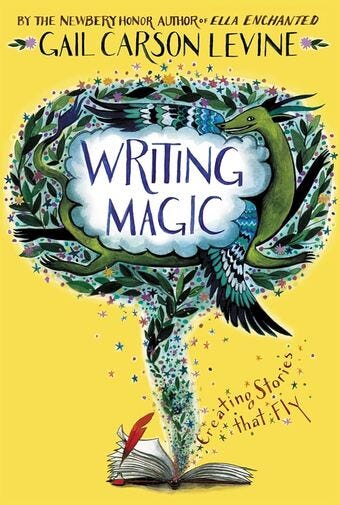My Rating: ★★★★★
Intro & Summary
Gail Carson Levine’s Writing Magic is a lesson in writing for young people originally published in 2006. With short, easy to read chapters in a fun and conversational voice, the book is a fast-paced master class in writing in general, but especially fiction.
Writing Magic was recommended by Elisabeth Wheatley, an author I follow on Instagram, among several other resources for writers. I thought it would be most effective as a follow-up to Stephen King’s On Writing.
Carson Levine, Gail. Writing Magic: Creating Stories that Fly. 2006. Reprint, New York: Harper, 2015.
Readability
Because Writing Magic is aimed toward younger writers (the back cover says “Ages 8 and up”), the text is simple and straightforward. Carson Levine never talks down to or patronises to the reader, though, which I think is one of the best ways to write books for young readers. It also means that adults can get plenty of information and even enjoyment out of the book.
I worked my way through the book in about 2 hours, which is considerably less time than it took me to get through On Writing (that took me about 6 hours). That didn’t include any time working on the writing exercises at the end of every chapter, for which Carson Levine recommends at least 20 minutes. I skipped them because I just wanted to read the book. But they’re very solid, and I’ll probably go back for at least a few of them.
With 30 chapters, that’s about 10 hours of writing, which is a pretty respectable amount of practise time at any age.
Learning
I think I got at least as much from Writing Magic as I did from On Writing. Maybe more, since King didn’t cover nearly as many topics as Carson Levine. A lot of the earlier chapters were review of the absolute basics of writing and getting down to writing. There was also a lot of crossover between this and King’s book, but the advice was of course worded differently, often with different context. I find I actually learn things better when they can be explained in a couple ways, so that was good reinforcement.
The other great part about Carson Levine’s writing is, much like King, she goes into the why of her advice. Because knowing or being told how to do something is one thing, but you really need to know why you should do it that way in order to better understand and get creative with it. And knowing why also helps you figure out when you can (or should) break the rules.
My favourite piece of advice from the whole book is from Chapter 17: Stuck! When you get stuck, write down 12 options. Don’t stop even when you hit on a good one. A later option might be as good or better. If you have multiple good options, then you have choices!
She also emphasises not to be afraid of writing down the bad ideas, or the stupid ones. Sometimes it’s good to get those out of your system to uncover the really good ideas. And sometimes what at first looks bad or stupid might be just the twist or solution the story needs. Can’t wait to leave no-context notes around for myself with lists of ideas, most of which will almost certainly be horrible or absurd. 😃
Would I Read It Again?
Yes.
I have to read it again for the writing exercises to be effective, as they build off of their respective chapters as well as earlier exercises in the book.
But more than that, I found this book valuable in terms of both advice and motivation. It’s going to sit happily on my shelf with On Writing for whenever I need a little boost.
Gail Carson Levine also has a newer (2014) book called Writer to Writer that I’ll probably check out in the near future. Looking at the table of contents, it gets a bit deeper into character and storytelling.



